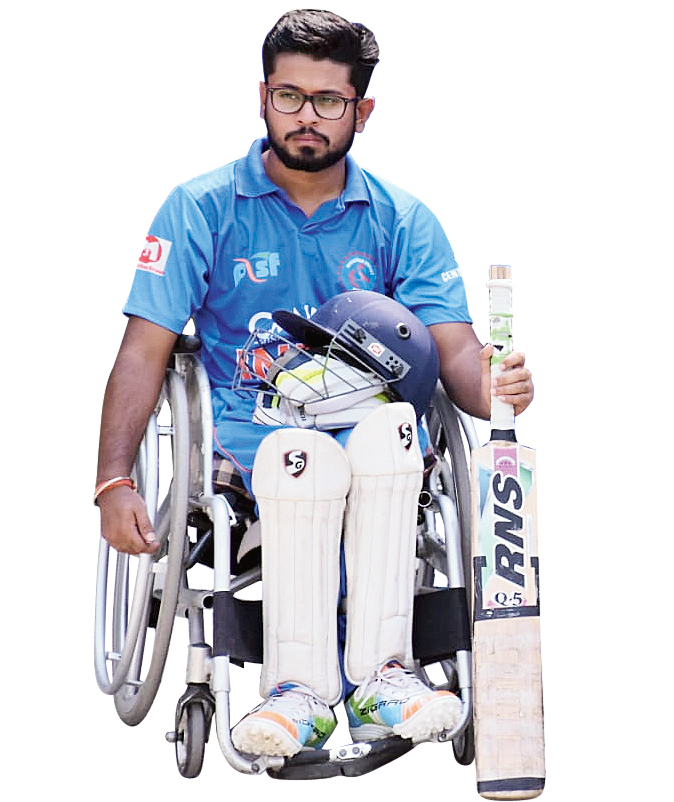Last weekend, away from the public eye, a three-nation T20 tournament took place in New Town. The players were in the jerseys of India, Bangladesh and Nepal. But it wasn’t as if international stars had sneaked out from the IPL teams. All the players in action were playing in wheelchairs, having little or no use of their lower limbs.
The tournament was being played in a round robin format and in the first match on Friday India posted a mammoth total of 226 for 1 against Nepal. Captain Somjeet Singh had played a stellar role by scoring 87 not out of 68 balls. Rohit Anotra too played a blitzkrieg of 44 off just 18 balls. His two sixes soared over the reduced boundary rope at the NKDA stadium. But he would not have got a chance to bat if Poshan Dhruw had not been caught short of his crease on a run-a-ball 36. One major difference in wheelchair cricket is how batsmen leave the bat behind in the crease when taking a run as they need both hands free to turns the wheels. So there is no scope to run in with an outstretched hand grounding the bat.
But with the scoreboard barely moving- after six overs, Nepal’s score was 10, soon it was clear that the teams were hardly equals in strength. “Our state team will beat them,” smirked Rizwan Ahmed, who was watching his mates field from the sidelines. Rizwan became paralysed at the age of five. “I discovered wheelchair cricket a year and half ago on YouTube. It was thrilling to learn that there is a India team too,” he smiled. Since then, he has been to Delhi, Meerut, Lucknow and Varanasi to play matches.
The team was training at Haldia before they reached New Town. “I own a restaurant but cricket is my passion. I teach the sport free at an academy I run,” smiled Santanu Bera of Haldia Eureka Sports Culture Welfare Society who was acting as the team’s coach, in between shouting out instructions on bowling change.
What the match lacked in competitiveness it made up for in controversy. Nepal objected to the bowling action of India’s Hareesh Kumar. “He is not bowling round arm,” they protested, causing the captain of the Bangladesh team to join a heated conference in the middle of the ground. “Our wheelchairs are such that the hand would face an obstruction from the handle if the bowlers try a round-arm action. There has to be some bending of the elbow,” a coaching staff explained.

The champions Bangladesh with the trophy (Sudeshna Banerjee)

A slice of action from the India-Nepal match at the NKDA stadium. (Sudeshna Banerjee) (Sudeshna Banerjee)

Somjeet Singh, the India captain (Sudeshna Banerjee)
The Nepal manager Krishna Chaudhary later explained to The Telegraph Salt Lake how he has bypassed this technical problem. “We have placed a four inch cushion on the seat. That raises our players above any possible obstruction from the handles,” said the man, whose brainchild the change was.
Even after the match resumed, wickets fell at regular intervals. “We had visa problems and injury issues, so six of our first team players could not come,” an official explained. “Many of these boys have played wheelchair cricket just for three or four days before this tournament.”
Captain Himal Aryal, though, was a veteran. The muscular player who has a military background is also the captain of the country’s wheelchair basketball team. “My first cricket match was in 2014 versus Pakistan,” he smiled, adding that he was a fan of Andre Russell and Mahendra Singh Dhoni.
Once the match reached the 15th over, there was a dust storm followed by a smart shower which caused the match to be discontinued. Nepal was then reeling at 54 for 6. Since both teams had played more than eight overs, it was counted as a match. The points were awarded to India on the basis of a target revised by the Duckworth Lewis method.
The next day India came up trumps over Bangladesh in a match curtailed to 10 overs but the latter still made it to Sunday’s final by defeating Nepal.
In the final Bangladesh posted 136 at the cost of eight wickets after being sent in to bat first by India. It was quite a sight to see fielders in wheelchairs swoop down on balls speeding towards the boundary. The reduced ground made sure they did not have to chase much.
This was the second trip to India for most of the players. “We had come to Delhi in 2017 for a bilateral three-match series. We had won 2-1,” said coach Mohd. Moniruzzaman, one of the few in the team who could walk. “When I decided to become a coach with the Dream for Disability Foundation I started moving around in a wheelchair to understand the issues the players face — how to quickly turn the wheelchair, bend down to pick up the ball or reach out to take a catch while being seated,” he said.
In the closely fought match, Bangladesh turned the tables on India which fizzled out in the 19th over, falling short of the target by five runs.
Dragging his wheelchair out of the ground, Mohd Abu-baker, a spinner, recalled how he was inspired to return to the field after suffering an accident at the age of 16. “If Mashrafe Mortoza, the Bangladesh captain, can have gone under the knife nine times and still play cricket why can’t I, I thought,” the Chittagong youth said.
This is what the tournament was about, more than wins and losses — inspiration to not give up. “We hope people in Bengal who are confined to wheelchairs become aware of the sport and come forward,” said an official of the organisers, Wheelchair Cricket India.











